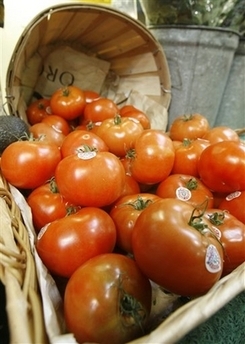WASHINGTON - The toll from salmonella-tainted tomatoes jumped to 228 illnesses Thursday as the government learned of five dozen previously unknown cases and said it is possible the food poisoning contributed to a cancer patient's death.
Six more states - Florida, Georgia, Missouri, New York, Tennessee and Vermont - reported illnesses related to the outbreak, bringing the number of affected states to 23.

|
| ©AP Photo/Toby Talbot
|
| Tomatoes with vines still attached are on sale at the Hunger Mountain Cooperative in Montpelier, Vt., Tuesday, June 10, 2008. U.S. officials hunted for the source of a salmonella outbreak in 17 states linked to three types of raw tomatoes, while the list of supermarkets and restaurants yanking those varieties from shelves and dishes grew. Cherry tomatoes, grape tomatoes, tomatoes sold with the vine still attached and homegrown tomatoes are likely not the source of the outbreak, federal officials said.
|
The Food and Drug Administration has not pinpointed the source of the outbreak. With the latest known illness striking on June 1, officials also are not sure if all the tainted tomatoes are off the market.
"As long as we are continuing to see new cases come on board, it is a concern that there are still contaminated tomatoes out there," said the agency's food safety chief, Dr. David Acheson.
Government officials have said all week they were close to cracking the case, but "maybe we were being too optimistic," Acheson acknowledged.
How much longer? "That's impossible to say."
On the do-not-eat list are raw red plum, red Roma or red round tomatoes, unless they were grown in specific states or countries that the FDA has cleared because they were not harvesting when the outbreak began or were not selling their tomatoes in places where people got sick.
The FDA is directing consumers to its
Web site for updated lists of the safe regions.
Also safe are grape tomatoes, cherry tomatoes and tomatoes sold with the vine still attached. That is not because there is anything biologically safer about those with a vine but because the sick have assured investigators that is not the kind of tomato they ate.
What if you did not go to the store armed with a list, or the store or restaurant manager cannot assure that any plum, Roma or round tomatoes came from safe regions?
"If you don't know, don't take the risk," Acheson said.
Cooking also kills salmonella, but the FDA is not formally advising people to cook suspect tomatoes for fear they will not get them heated thoroughly.
Mexico and parts of central Florida, two chief tomato suppliers, are still on FDA's suspect list. But the agency would not say they were top suspects, and in fact, said certain parts of Mexico that were not harvesting when the outbreak began are working to be cleared.
At least 25 people have been hospitalized during the outbreak, caused by a relatively rare strain of salmonella known as Saintpaul.
"At this point, there isn't a lot of data to suggest this is a more virulent strain," said Dr. Ian Williams of the Centers for Disease Control and Prevention.
No deaths have been attributed to the salmonella. But the CDC for the first time Thursday acknowledged that the salmonella may have been a contributing factor in the cancer-caused death of a 67-year-old Texas man.

Reader Comments
to our Newsletter